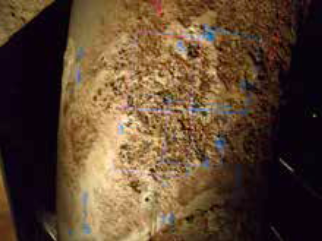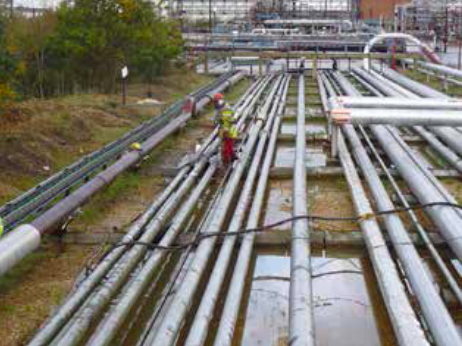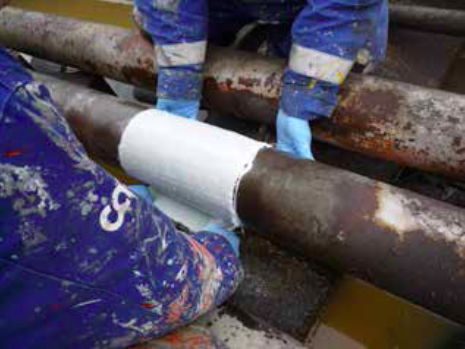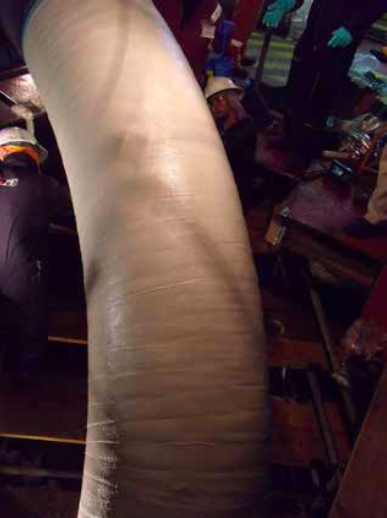Composite repair systems can be a great option for owner/ operators to extend the life of their assets without disrupting operations. Consider the following scenario; it may seem familiar to some readers:
The mood was tense in the planning room. The pipe section was badly corroded beyond the acceptable corrosion allowance and it was feared that a leak could develop at any minute. As a matter of fact, the guys in maintenance had a [prediction] pool going to see who could guess when it would finally give. This is not to discredit the seriousness of the situation; this particular issue was on a large diameter, offshore riser located in the Indian Ocean on the main platform that supplies a country with more than half of its total natural gas used for power generation. If this line were to fail, the resulting consequences would paralyze the country’s power generation capacity, creating an economic and environmental disaster. The discussion had been dragging on for days on how to best handle the situation. Welding was out of the question due to the dangers associated with that option. Shutting down and replacing this damaged section of pipe was also not a possibility due the long turnaround time which would freeze the country’s power grid for weeks. Clamps could possibly work, but getting a custom clamp manufactured to fit this particular section (large diameter, with corrosion on a long length of pipe including a bend) would be costly, take several weeks, and be a nightmare to install; not to mention the required cranes and other large machinery that would be needed to support the installation. That’s when someone mentioned another option that could potentially save the day…

While the tone of the this story may be a bit dramatic, it is an all-too-common occurrence in the oil and gas industry today, as critical assets have surpassed their design life or have experienced severe corrosion damage, and in many instances the need for repair or replacement is truly dire. This specific case will be discussed a bit later, but it is a good example of how composite repair systems are viewed in the industry today. Even though they have been successfully and routinely used by many pipelines, refineries, power plants, and offshore rigs, as well as many other industries and markets, they are still relatively new when compared to many of the more traditional methods previously used. Composite repair materials may still be viewed as a last resort or emergency option, but the author believes that a strong case may be made for more widespread use in a more preventative maintenance role, and this is being confirmed more and more by continued and increased usage worldwide.
As composite repair technology continues to gain acceptance and is being more widely utilized, owner/operators are finding that they are useful in a variety of situations. The days of thinking of composite repair materials as a last resort or even as a new or risky option are slowly, but surely, fading. When the ASME PCC-2 and ISO/TS-24817 were first published in 2006, the idea of composite repairs being used for high risk or Class 3 piping repairs was still a novelty. Over seven (7) years later, repairs are being implemented using this technology on a daily basis as part of the routine maintenance programs in facilities and on pipelines around the world. Advancements in composite technology, stronger industry guidelines and standards, mandated third party testing requirements, and the overall increase in educational efforts for this method of pipe repair has quickly moved composites to a more respected and often utilized position in the oil and gas industry. By being more proactive and using composite repair systems to fix corrosion issues before they get too far out of hand, owner/ operators are greatly increasing the safety, efficiency, and production capabilities of their facilities.

A great example of this shift in mindset has been occurring in a large oil refinery located in Southeast Asia. Beginning in 2010, the plant engineering and maintenance departments were utilizing composite repair systems for a common application need in their facility. Specifically, their issue was with external corrosion at pipe supports. Within the approximately 50 year old facility, there are thousands of pipe supports with outdated design structures that were prone to experiencing crevice corrosion and abrasion.
A well-known composite repair system was fully vetted and duly qualified by the refinery staff for compliance with industry standards (the ASME PCC-2 and ISO/TS-24817), and the manufacturing company reviewed and audited for competency and quality certifications. After the full and detailed review and subsequent acceptance/approval, the facility set about repairing the corroded pipe support areas under a newly minted program called CAIR (Corrective Action Inspection Repair).
Beginning with the most heavily corroded pipes, the maintenance contractor has spent the last few years installing the composite repair system on the support areas to restore the pipe’s original design parameters, as well as prevent future corrosion from occurring while keeping the piping systems in full operational status. This was a major action plan for the facility to undertake, but it has certainly paid off in a big way. Within the first two years, the maintenance and inspection departments have reported an 80% reduction in the number of leaks within the units that have implemented the CAIR program for composite repairs. This translates directly into a safer working environment and high operational savings for the plant, as it is much cheaper to perform proactive and preventative maintenance using composites early on in the pipe’s operational life versus performing reactive maintenance when a leak occurs, requiring dangerous and costly repair methods that could result in a facility shutdown or other problems.

While this is a good example of how being proactive and using a great repair tool can be an effective means to prevent problems and reduce maintenance costs in the long run, there are times when situations are unavoidable and there is an immediate need. Let’s go back to our initial discussion of the large diameter riser pipe. During the planning session, it was brought to the attention of the group that composite repair could be a viable option to repair and extend the life of the corroded natural gas export line. For this offshore exploration group, composite repairs had not yet been fully and formally introduced into practical field usage. After meeting with the engineering group and working with the manufacturer on the product testing, history, detailed design methods, and installation requirements, it was agreed that a composite repair was indeed the best way forward on this project.
The entire process for this project from evaluation to implementation was well documented by the government’s power generation agency & the client’s inspection team to ensure full compliance during all aspects of the installation. The composite repair system was successfully installed in 2009 returning this 32” OD, natural gas, export line back to its full test pressure rating of 1,960 psi (135 bar). Due to the critical nature of this specific project and the vital role of this pipe for the supply of natural gas to the region, the repair attracted much attention and was a featured story of CNBC.
A new in-line inspection of this pipe which was completed in 2012 revealed that no further corrosion has occurred in the repaired area. A follow up inspection of the composite repair indicated that it was also in excellent condition, and was therefore subsequently commissioned to remain in service until 2016 when another inspection will be completed, or the client chooses to fully replace the pipe section during a scheduled shutdown. It is currently still in successful operation today.


These are only a couple of common examples of how composite repairs are being implemented and used in today’s oil and gas industry. While there is no such thing as a “silver bullet,” and composites do have their limitations, there is a wide range of applications suited for use of this repair technology. Repairs using composite materials can be found in the marine, power generation, mining, automotive, aerospace, civil infrastructure, and of course, the oil and gas industries, just to name a few. The future is wide open for this relatively new and unconventional repair option, and with more and more companies using composite repair materials every day, they will soon become the norm rather than the exception.
















Comments and Discussion
Add a Comment
Please log in or register to participate in comments and discussions.